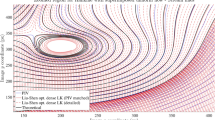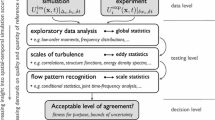Abstract
A reliable validation based on the optical flow visualization for numerical simulations of complex flowfields is addressed in this paper. Several test cases, including two-dimensional, axisymmetric and three-dimensional flowfields, were presented to demonstrate the effectiveness of the validation and gain credibility of numerical solutions of complex flowfields. In the validation, images of these flowfields were constructed from numerical results based on the principle of the optical flow visualization, and compared directly with experimental interferograms. Because both experimental and numerical results are of identical physical representation, the agreement between them can be evaluated effectively by examining flow structures as well as checking discrepancies in density. The study shows that the reliable validation can be achieved by using the direct comparison between numerical and experiment results without any loss of accuracy in either of them.
Similar content being viewed by others
References
Babinsky H, Meguro T, Jiang Z, et al. Numerical visualization of shock wave flow in an expanding tube and comparison with experiment. In: Khalighi et al. eds. Exp and Numerical Flow Visualization, Vol 218, ASME, Hilton Head, South Carolina, 1995, 89–94
Babinsky H, Takayama K. CFD validation strategies for compressible flow using interferometry. AIAA 96-0438, 1996
Havener AG, Obergefell LA. Computational interferometric description of nested flow fields.Optical Engineering, 1985, 24: 441–445
Yates LA. Images constructed from computed flow-field.AIAA Journal, 1993, 31: 1877–1884
Jiang Z, Takayama K. An investigation into the validation of numerical solutions of complex flowfields.J Computational Physics, 1999, 151: 479–497
Inoue O, Takahashi M, Takayama K. Shock wave focusing in a log-spiral dust.AIAA Journal, 1993, 31: 1150–1155
Sasoh A, Takayama K, Saito T. A weak shock wave reflection over wedges.Shock Waves, 1992, 2: 277–283
Sun M, Takayama K. A holographic interferometric study of shock wave focusing in a circular reflector.Shock Waves, 1996, 6: 323–336
Takayama K, Jiang Z. Shock wave reflection over wedges: a benchmark test for CFD and experiments.Shock Waves, 1997, 7: 191–203
Jiang Z, Liu J, Ni G, et al. The calculation of the density field from axisymmetric schlieren interferograms by the image processing techniques.Acta Mechanica Sinica, 1993, 9: 22–26
Sharma SP, Ruffin S. Density measurements in an expanding flow using holographic interferometry. AIAA 92-0809, 1992
Bone DJ. Fourier fringe analysis: the two-dimensional phase unwrapping problem.Applied Optics, 1991, 30: 3627–3632
Parker SCJ. The quantitative analysis of transonic flows by holographic interferometry. [PhD Thesis], University of Warwick, UK, 1993
Morton JW, Houwing AFP, Boyce RR, et al. Tomographic reconstruction of jet and shock layer flows. In: Houwing et al eds. Proc of the 21st Int Symp on Shock Waves, Vol 1, Great Keppel Island, Australia, July 20–25, 1987. 435–441
Takeda M, Ina H, Kobayashi S. Fourier transform method of fringe-pattern analysis for computer-based tomography and interferometry.J Optics Soc Am, 1981, 22: 824–831
Jiang Z, Takayama K, Babinsky H, et al. Transient shock wave flows in tubes with a sudden change in cross section.Shock Waves, 1997, 7: 151–162
Jiang Z, Onodera O, Takayama K. Three-dimensional reflection of shock waves propagating in square cross-sectional tubes. In: Houwing et al. eds. Proc of the 21st Int Symp on Shock Waves, Vol 2, Great Keppel Island, Australia, July 20–25, 1987. 1499–1501
Tam TC, Brock NJ, Cavolowsky JL, et al. Interferometry at the NASA-Ames hypervelocity free-flight aerodynamic facility. AIAA 91-0568, 1991
Tamura Y, Fujii K. Visualization for computational fluid dynamics and the comparison with experiments. AIAA 90-3031, 1990
Jiang Z, Takayama K, Chen YS. Dispersion conditions for non-oscillatory shock capturing schemes and its applications.Comp Fluid Dynamics J, 1995, 2: 137–150
Jiang Z, Chen YS, Kuwahara K. Approximate non-reflecting inflow-outflow boundary conditions for calculations of Navier-Stokes equations for internal flows.Acta Mechanica Sinica, 1993, 9: 289–297
Zhuang FG. On numerical techniques in CFD.Acta Mechanica Sinica, 2000, 16: 193–216
Takayama K, Onodera O. Shock wave propagation past circular cross sectional 90° bends. In: Archer, Milton eds. Proc of the 14th Int Symp on Shock Tubes and Shock Waves, University of Sydney, New South Wales, Australia, 1983, 205–211
Abe A. Shock waves discharged from the open end of shock tubes. [Doctoral Thesis], Graduate School of Tohoku University, Sendai, Japan, 1991
Author information
Authors and Affiliations
Rights and permissions
About this article
Cite this article
Zonglin, J. Reliable validation based on optical flow visualization for CFD simulations. Acta Mech Sinica 19, 193–203 (2003). https://doi.org/10.1007/BF02484479
Received:
Revised:
Issue Date:
DOI: https://doi.org/10.1007/BF02484479




